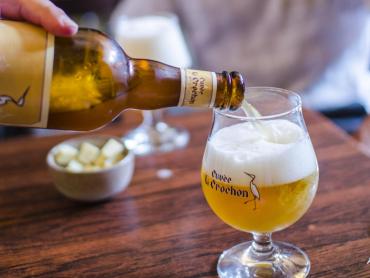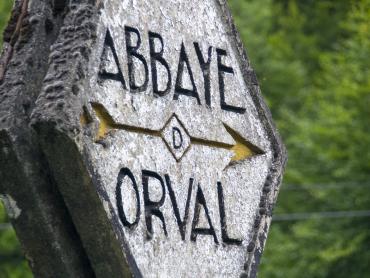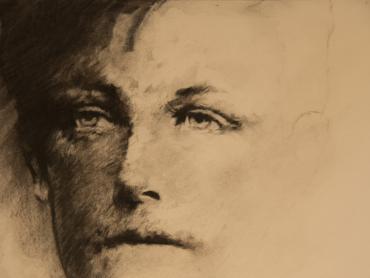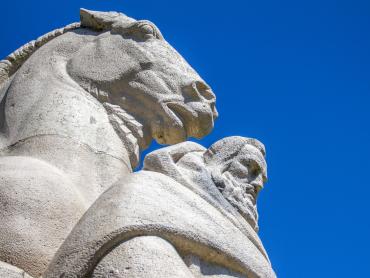Le voyage de légendes (Le voyage de légendes )
Saint-Hubert, capitale européenne de la chasse, est aussi une terre propice à la contemplation. La forêt, immense, est source inépuisable de randonnées parmi les plus belles du pays. Elle est également un livre ouvert sur le merveilleux médiéval.
À Saint-hubert
A - The abbey church Voir sur la carte
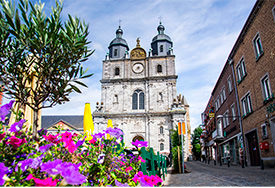
This abbey church with its Gothic interior dotted with Renaissance elements was raised to the rank of basilica in 1927. The Romanesque crypt, which dates from the 11th century, still exists. It has five naves, an ambulatory and several chapels. This outstanding heritage site of Wallonia houses a permanent exhibition on the worship of Saint Hubert.
À Saint-hubert
B - The legend and the abbey Voir sur la carte
The year is 683. A young hunter, Hubert, moves silently through the sprawling Ardennes forest. Suddenly he spots a large deer. Taking aim with his bow, he sees a luminous cross between the two antlers of the animals. A revelation that was to prompt this idle man from the court of the Rois Fainéants or ‘lazy kings’ to convert. A healer of rabies, he was named patron saint by hunters. The legend was born, but the reality was rather different… In the 7th century, Hubert was the evangelist of a region where Christianity was finding it difficult to penetrate the dark massif. Saint Hubert became the first bishop of Liège and died in 727. His remains were taken to the very heart of the Ardennes, to the desolate Andage plateau. Benedictine monks settled there and founded an abbey, one of the oldest and most illustrious in western Europe: the cult of Saint Hubert was born and took the name of the new city. In the 11th century, the Benedictine abbey prospered and founded a number of priories. The abbey, which was rebuilt in 1729, remains an architectural gem at the heart of the Ardennes forest.
Did you know?

As in all isolated regions, Christianity had a hard time becoming established in the Ardennes. The tenacity and extremist attitude of preachers like Remacle and Hubert crossing the marshes and the forests were unable to eradicate popular beliefs. The legends have survived right to the present day.
À Saint-hubert
C - The old hospital Voir sur la carte
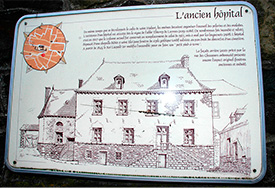
In the 11th century, pilgrims did not hesitate to cross the Ardennes massif to honour Saint Hubert. Exhausted and numb, they found the comfort they needed in a hospital.
rue de la Fontaine 23
6870 Saint-hubert
Tel : 0032(0) 61 41 69 65
Web : www.ancienhopital.be
Did you know?
The present-day building bears little resemblance to that which stood here in the Middle Ages. King Leopold I was to make it a ‘small’ pied-à-terre… These days it comprises a hotel-restaurant and a wine bar.
À Saint-hubert
D - Our Lady of Hurtebise monastery Voir sur la carte
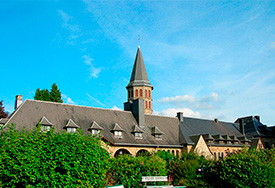
Along the Abbeys Route, not far from Saint-Hubert, there is a small, peaceful corner, bathed in stillness. This haven of peace nestling in its forest setting is the Our Lady of Hurtebise monastery.
Far removed from daily life, which can be stressful and hectic, the Benedictine cloistered nuns who have lived here since 1938 welcome all who need to take a break to recharge their emotional, mental and spiritual batteries.
À Saint-hubert
E - Walking

The great Ardennes forest
Unfortunately, the big denizens have disappeared from this mythical land. Just imagine, 900 years ago red bison still lived here, the biggest game, roaming the forests in herds of ten to fifteen animals. Charlemagne loved to hunt European bison and aurochs, the ancestor of our oxen. It was all very impressive for pilgrims or merchants who dared venture into the forest, particularly the brown bear that hibernated there for three or four months. Woe betide anyone who disturbed it! The long winters saw hordes of starving wolves crossing the Ardennes. At night peasants, frozen with dread in their little cottages, could hear them howling. Inhabited by wild beasts, the medieval Ardennes forest stretched more than 700 kilometres, from the outskirts of Paris to the Rhine. No, travelling through the forest was not a good thing in those days…
Did you know?
The forest remained the first land to be conquered. By clearing the forest, at the same time the monks overcame the devilish forces of pagan beliefs.
Tip
Never fear, Saint-Hubert Forest has become far more hospitable! It boasts a great many walks. But our favourites are the ones that head for King Albert’s woods. A lovely map from the National Geographic Institute of Belgium collects together all the other waymarked walks.
To go further afield
‘Saint-Hubert’ walking map on sale at the Pays de Saint-Hubert tourist office.
À Saint-hubert
F - The Pierre Redouté museum Voir sur la carte
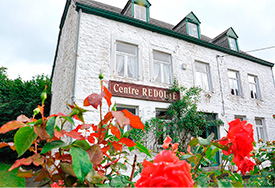
The ‘Raphael of flowers’ was born in Saint-Hubert in 1759. Exiled to Paris, he painted with the leading figures of this world. Using his talent as a watercolour painter, he produced plates of plants and flowers for the leading botanists of his time. This ability to draw flowers brought him some marvellous opportunities. He was appointed official artist to the court of the King of France. An unusual career for this man who experienced the major political upheavals of his time. Queen Marie-Antoinette, the Empress Josephine and Louise-Marie of Orleans, first queen of the Belgians, were among his pupils.
Contact
rue Redouté, 11
6870 Saint-hubert
Tel : 0032(0) 49 89 02 822
Web : https://www.museepjredoute.be
À Saint-hubert
G - The Converserie Voir sur la carte
Standing alongside the express way, the Converserie has stood on the route followed by travellers for centuries. This hospice welcomed pilgrims, travellers and the poor.
Did you know?
The Converserie takes its name from the lay or secular brothers (frères convers) who did manual labour in the forest. Their lower rank within the abbey prevented them from devoting themselves to studying the Opus Dei, the work of God.
Walking
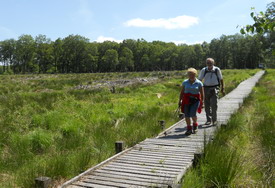
The ‘Rouge Poncé’
In the Sylvia Arduina, the great Ardennes forest, your footprints will mingle with the tracks of wild animals. The forest envelops you, becoming vast as it hangs with threads of mist at dawn, when its outlines are blurred. This walk explores the soul of the great green world and its marvels. Impenetrable at the time of Jules Caesar, the forest was to be tamed by men, who earned a living from it. Pragmatic yet dreamers, they peopled it with fantastic beasts; it reflected their anxiety when they entered it! And nothing has changed since… When you walk in Saint-Hubert Forest, when you take the trouble to listen to it, to sense it, the marvels are all around you. The Masblette stream sparkles and leaps from rock to rock, the lines of beech trees near Rouge Poncé open up great windows of light, as if you were in a cathedral. Everything is subject to interpretation, to the creation of legends. You won’t get bored as you cover these twenty kilometres.
Did you know?
The Rouge Poncé birch grove is the oldest estate nature reserve in the Walloon Region, as it was created in 1969! This amazing birch tree forest was a regular feature of the Ardennes before the region was dried out to grow and exploit conifers.
Practical details
Distance: 20 km
Waymarking: blue rectangle
Difficulty: difficult
Time: 5 hrs
Start: on the N 89, go towards the aerodrome. There is a parking area alongside the express way.
To go further afield
‘Saint-Hubert’ walking map, on sale at the Pays de Saint-Hubert tourist office.
Walking

The Basseille fen
In the early morning, hoar frost covers the vast Saint-Hubert Forest. The oak and beech trees become frozen statues until the sun breaks through the mist, bringing its warmth. In Laneuville-au-Bois, the path enters the grand massif straight away. Nature is very close to this hamlet at the end of the earth! In just a few steps, you are caught. The farther you walk, the more you penetrate this forest of no return. It seems to go on forever. And yet it is not dark or sad. The broad-leaved trees absorb some of the light, but leave other rays to light up the ground, the streams and the rocks. The path leads to a lost valley with a few scattered birch trees, isolated in the midst of a moor. And the silence… close your eyes and listen to the silence of immense spaces.
Tip
There are four observation posts dotted around Saint-Hubert forest, from which you can see and sense. These remarkable structures blend into their surroundings and, if you are lucky, enable you to observe wildlife as you have never seen it before. You can almost touch it! These four posts are indicated on the most recently published version of the map of walks in Saint-Hubert.
Practical details
Distance: 13 km
Waymarking: yellow cross
Difficulty: difficult
Time: 5 hrs
Start: on the N 89, walk towards the aerodrome. There is a parking area along the expressway.
To go further afield
Tellin’ walking map, on sale at the Pays de Saint-Hubert tourist office.
À Saint-hubert
H - Tourist reception site Voir sur la carte

Maison du Tourisme du Pays de St Hubert
place du Marché, 15 - 6870 Saint-Hubert
+32 (0)61/61.30.10
info@saint-hubert-tourisme.be
Open all year round from 9 am to 5.30 pm exept 1st January and 25 December.
À Fourneau Saint-Michel
I - The forges Voir sur la carte
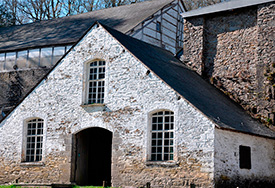
1780… the coffers of Saint-Hubert Abbey were empty! The abbot decided that they needed to build blast furnaces, quickly! He was an ambitious man and wanted to break the monopoly of the Liège iron and steel industry, which was booming. The site was chosen: it was to be at Saint-Michel. The ideal setting. The forests provided the fuel needed for the furnaces: charcoal. And the rivers with their strong currents produced the power needed to activate the bellows and the hammers, the makas. “This is the finest blast furnace in the Province…” the abbot boasted… But haste is a poor counsellor: the men were clumsy, more accustomed to using an axe. The quality of the Jemelle ore was poor. Things got off to a bad start! In the New World, the cannons were rumbling: the American War of Independence began. Benjamin Franklin, the future president, came to Europe and bought weapons, lots of weapons. In Liège, the makas worked around the clock. The city became the arsenal of the Revolutionaries. The abbot wanted some of the spoils: he, too, would make cannons! And too bad about the ethics. Unfortunately, the forge produced the cannon muzzles too quickly. They exploded one by one… Ruin came. The blast furnace that had spewed out so much smoke and dust was extinguished forever.
350€
rue de Bredewee 369
6717 Attert
Tip
These days, the forge maker’s building, the coal market and the blast furnace, still intact, bear witness to the entrepreneurial abbot’s dreams of grandeur.
À Fourneau Saint-Michel
J - An open-air museum Voir sur la carte

Comprising over fifty buildings, this museum shows the living conditions of rural Wallonia in the 19th and early 20th centuries. Following a route of 600 metres, you will see houses from ten geographic regions to the south of the Sambre and the Meuse, including the Semois, Gaume, eastern Ardennes, Condroz and Hesbaye regions. Remarkably, these original structures were dismantled and then rebuilt here, exactly as they were, including their interior fittings!
350€
rue de Bredewee 369
6717 Attert
Tip
Travel through time in this museum, which depicts life in Wallonia in the 19th century. A visit that we warmly recommend after the walks of Fourneau Saint-Michel or Saint-Hubert.
Walking
Masblette valley
In 1771, the last abbot of Saint-Hubert, Dominique Spirlet, wanted to restore the prestige of the abbey. He industrialised Masblette valley by building a blast furnace. To supply the water needed, the river was channelled, artificial lakes were created and hundred-year-old oaks were felled. And yet this industrial age proved short-lived… In 1781, the blast furnaces were shut down. The quality of the iron produced was clearly sub-standard.
Tip
The traces of this fleeting industry can still be seen as you follow the route alongside the river from the museum.
Practical details
Distance: 9 km
Waymarking: red rectangle
Difficulty: average
Time: 3 hrs
Start: from the Iron Museum (closed for restoration), on the N 849, just after the Museum of Rural Life.
To go further afield. ‘Saint-Hubert’ walking map, on sale at the Pays de Saint-Hubert tourist office.
Pour aller plus loin
Carte de promenade, Saint-Hubert, en vente à la Maison du Tourisme du Pays de Saint-Hubert
À Mirwart
K - The estate Voir sur la carte
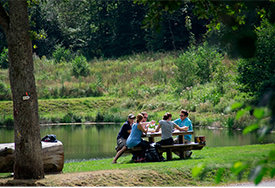
Mirwart is like an island at the heart of one of the biggest forests in the country. The provincial estate covers 1,350 hectares, consisting largely of a superb forest with various species. The estate also includes a fish farm renowned for the quality of its brown trout: why not see for yourself by going to one of the lakes surrounded by the vast forest.
Four waymarked paths with didactic panels. Didactic walk in the pond valley.
training courses ( check on notebook) and guided visits (on reservation) french and dutch. Fly fishing individual initiation (on reservation).
For groups and firms (on reservation). Visit of fish breeding, walk in the estate. Fish initiation in the pond. River fly fishing initiation, the paradise for the fly fisherman
rue du Moulin, 16
6870 Saint-hubert
Tel : 0032(0) 84 36 62 99
Web : http://www.province.luxembourg.be/fr/domaine-provincial-de-mirwart.html?IDC=3542
Did you know?
The Mirwart estate, owned by illustrious families such as the La Marcks and the d’Arenbergs, was once very powerful. Wood was, of course, its main source of wealth. Cut locally, the trunks were floated down the Lhomme and the Lesse rivers to the Meuse basin, where they were used by the glassmakers and blast furnaces until the end of the 18th century.
Tip
The walks in the estate explore the magnificent selection forest of Mirwart. Several species of various ages can be found side by side there. As you walk, you will be able to admire the soaring beech trees and the play of light they create.
To go further afield
‘Saint-Hubert’ walking map, on sale at the Pays de Saint-Hubert tourist office.
À Mirwart
L - The brigands’ fortress Voir sur la carte

Standing on a rocky promontory overlooking the Lhomme valley, Mirwart Castle became a residential property in the 18th century. Previously, a fortress had stood there, built by a lord of Lotharingia who wanted to protect himself against the warlike lords of Bouillon and Orchimont. The lords of Mirwart themselves became shameless oppressors…
Did you know?
Downstream of the Mirwart estate, the mill bears witness to the seignory’s tumultuous past. This ordinary mill, where the lord collected dues, remained in operation until 1918, when it fell into disuse. In 1951, the province of Luxembourg bought the ruins. It has now become an overnight gîte. Downstream, you can explore the Pré des Forges estate nature reserve, a freely accessible alluvial plain covering 24 hectares.
Walking Voir sur la carte
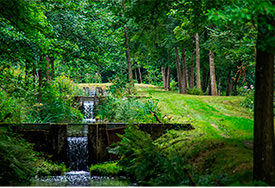
The Water path
The route follows these paths along the water once used to supply the sawmill blades. The plays of light and the leaves reflected in the many lakes could easily have provided inspiration for the impressionist painter Monet. In the early 19th century, the Parisian Aimé Gabriel, owner of the Vôneche crystal works, was in dire need of wood for his factory, which devoured fuel. He bought the Mirwart estate and set up lakes and dams. The Mârseau stream was channelled and tamed, and its water was used to operate the sawmills. To carry the precious wood to the valley, a local railway line was built at Mirwart: the bridge of Artigues stone bears witness to this industrial past at the heart of the Ardennes.
Practical details
Distance: 5 km
Waymarking: red triangle
Difficulty: easy
Time: 2 hrs
Start: from the estate reception centre, walking panels next to the car park.
To go further afield
‘Saint-Hubert’ walking map, on sale at the Pays de Saint-Hubert tourist office.
Did you know?
In the Ardennes, the land is thankless, difficult to cultivate. But the forest gave people a means of subsistence. In the 15th century, charcoal burners cleared the land left, right and centre: the deforestation of the grand massif continued until the 19th century. Charcoal was produced in clearings known as aires de faulde. Around a central chimney, the charcoal burner piled up the pieces of wood to form a stack and then covered it with earth. Cut off from oxygen, the wood was carbonised as it burnt, losing its humidity and vegetable matter. The charcoal burners were peasants who lived in the woods for several weeks to watch over these hearths which regularly caused forest fires. A reproduction of one of their cabins can be seen to the left of the path.






